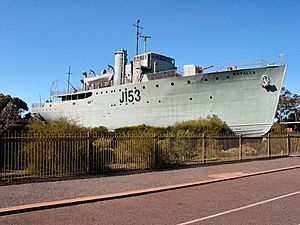HMAS Whyalla (J153) facts for kids

HMAS Whyalla
|
|
Quick facts for kids History |
|
|---|---|
| Namesake | City of Whyalla |
| Builder | BHP, Whyalla |
| Yard number | 8 |
| Laid down | 24 July 1940 |
| Launched | 12 May 1941 |
| Commissioned | 8 January 1942 |
| Decommissioned | 16 May 1946 |
| Honours and awards |
|
| Fate | Sold into civilian service |
| Victorian Public Works Department | |
| Name | Rip |
| Acquired | 10 February 1947 |
| In service | 1947 |
| Out of service | 1984 |
| Reclassified | Lighthouse maintenance vessel |
| Fate | Sold in 1984 |
| Whyalla City Council | |
| Name | Whyalla |
| Acquired | Late 1984 |
| Status | Landlocked museum ship |
| General characteristics during RAN service | |
| Class and type | Bathurst-class corvette |
| Displacement | 733 tons (standard) |
| Length | 186 ft (57 m) |
| Beam | 31 ft (9.4 m) |
| Draught | 8.5 ft (2.6 m) |
| Propulsion | triple expansion engine, 2 shafts |
| Speed | 15 knots (28 km/h; 17 mph) at 1,750 hp |
| Complement | 85 |
| Armament |
|
HMAS Whyalla (J153/B252) was a special kind of warship called a corvette. It was named after the city of Whyalla in Australia. This ship was one of 60 similar vessels, known as Bathurst-class corvettes, built during World War II.
Whyalla was first used by the Royal Australian Navy (RAN). After the war, it was sold and became a maintenance ship named Rip. Later, in 1984, the Whyalla City Council bought it. Today, it is a museum ship displayed on land in Whyalla.
Contents
Building a Warship: HMAS Whyalla
What is a Corvette?
In 1938, Australia's navy needed a versatile ship. This ship had to be good at finding submarines and clearing mines. It also needed to be easy to build and operate.
The first idea was for a ship around 500 tons. It would travel at least 10 knots (about 18.5 km/h). Its range would be 2,000 nautical miles (about 3,700 km).
The Bathurst-Class Design
The design changed to a larger ship, about 680 tons. It could go faster, up to 15.5 knots (about 28.7 km/h). Its range increased to 2,850 nautical miles (about 5,280 km). This new design included a 4-inch gun and asdic (a type of sonar for detecting submarines). It could also carry depth charges or minesweeping gear.
These ships were called "Australian Minesweepers" to keep their anti-submarine abilities a secret. People often called them "corvettes." During World War II, 60 of these ships were built.
Where Whyalla Was Built
Whyalla was built by BHP at its shipyard in Whyalla. Construction started on July 24, 1940. The ship was launched on May 12, 1941. It officially joined the navy on January 8, 1942. Whyalla was the very first ship built at the Whyalla shipyard.
Protecting Convoys in 1942
In 1942, Whyalla helped protect groups of ships, called convoys, along Australia's coast. It was in Sydney Harbour when Japanese mini-submarines attacked on May 31, 1942.
A few days later, Whyalla was escorting a convoy. A Japanese submarine, I-21, sank the freighter Guatemala. This was the only ship lost from a convoy that Whyalla was protecting.
Action in New Guinea
In December 1942, Whyalla went to New Guinea. There, it escorted convoys and helped map the waters. It was also involved in the lead-up to the Battle of Buna-Gona.
On January 2, 1943, Japanese dive-bombers attacked Whyalla and two smaller Australian survey ships. Whyalla had minor damage from bombs that exploded nearby. Two crew members were hurt by small pieces of metal. The ship kept doing survey work until April 1943.
Surviving Attacks and Helping Others
Whyalla then went to Milne Bay. It was there when about 100 Japanese aircraft attacked the anchorage. Again, Whyalla was not badly damaged. It helped its sister ships, Kapunda and Wagga, rescue people and save damaged equipment.
Later War Service
In June 1943, Whyalla returned to Australia for repairs. After that, it guarded convoys off Australia's east coast until February 1944. From February to June, it patrolled for submarines. Then, it went back to New Guinea.
In December 1944, Whyalla joined the British Pacific Fleet's 21st Minesweeping Flotilla. It spent the rest of the war clearing mines, escorting ships, and hunting submarines. It also took part in the Battle of Okinawa in 1945. After the war ended, Whyalla operated in Hong Kong for a short time. It returned to Brisbane in October 1945 and was officially taken out of service on May 16, 1946.
For its service, Whyalla earned three special awards called battle honours: "Pacific 1942–45", "New Guinea 1942–44", and "Okinawa 1945".
On February 10, 1947, Whyalla was sold to the Victorian Public Works Department. The ship was changed for civilian use and renamed Rip. It was towed to Melbourne and became a lighthouse maintenance vessel. Its job was to look after lighthouses at the entrance to Port Phillip Bay. The ship worked until 1984 and was then going to be sold for scrap metal.
A Museum Ship: Whyalla Today
When the Whyalla City Council heard the ship would be scrapped, they decided to buy it. They paid $5,000 for Whyalla. A team of 11 volunteers sailed the ship back to Whyalla in late 1984.
The ship stayed in its original launching area until April 1987. Then, it was moved 2 kilometers (about 1.2 miles) inland. On October 29, 1988, it became the main attraction of the Whyalla Maritime Museum. Whyalla is one of only two Bathurst-class corvettes that are still around as museum ships today. The other is HMAS Castlemaine.


